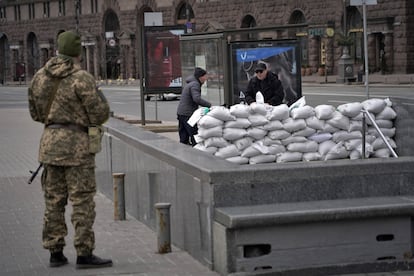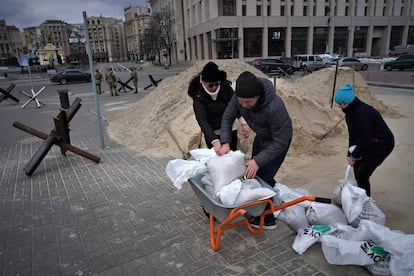How the citizens of Kyiv quickly organized a civilian resistance
From retired colonels leading neighborhood watches to cooks preparing sandbags, thousands of people are doing their best to hold off the Russian tanks

Oleg fought in Afghanistan in 1987, when Ukraine was part of the USSR. These days he is a retired colonel from the Ukrainian army who is leading one of the command posts of the civilian resistance against the Russian invasion. Standing amid barricades made with sandbags, concrete blocks and metal spikes in one of the outlying neighborhoods of the capital Kyiv, he declines to have his picture taken and cautions against publishing any specific information about his location.
The group of men that he is leading take turns to carry out checks on passing vehicles and suspicious-looking individuals, 24 hours a day. But most of them are not carrying any weapons, at least not in sight. While blasts can be heard in the background, cold weather appears to be their nearest enemy right now. Several men are warming their hands on a firewood stove made out of an oil drum, others are unloading ‘Molotov cocktails’ from a car, and yet others are making coffee on a table. Oleg says he wishes there were more cigarettes, but is grateful for the help they are getting from the neighbors, including the women who bring them food.

“At night we organize night patrols to detect the groups of thieves who, unfortunately, are taking advantage of the country’s war situation to steal things,” says Oleg, who is one of the veterans in the group. “I know how to handle weapons and I can teach youngsters without military experience.” Oleg says he is coordinating to some degree with Ukraine’s armed forces, but declines to provide details because it is “a military secret.”
Sergei, 48, has a Mossberg rifle slung over his shoulder. He says he is glad to have returned to Ukraine “two days before the war began,” because he feels it is his duty to defend his country even though he is not a professional soldier and his only training dates back to his military service three decades ago. A professional diver by trade, he was in Nigeria right before the invasion, working on an offshore gas platform.
For now at least, the battles are still taking place far from the city center. The Ukrainian army began blowing up the bridges providing access into the capital several days ago, in a bid to prevent Russian tanks and other combat vehicles from rolling right in. But the city is full of checkpoints like this one. And most of the lanes on the main avenue that runs by the central Independence Square have been blocked with large metal and concrete obstacles. This has become a very real danger at night, when drivers sometimes crash into them. Totaled vehicles have become an integral part of the barricades throughout the city.
In Independence Square, the symbol of the 2014 Euromaidan revolution, citizen volunteers are also getting ready for a potential attack. Women are filling bags with sand to erect barricades blocking access to the subway system entrances. Raisa, a 53-year-old cook, says she is “too old to flee” and is instead volunteering in the effort to hold back the Russian tanks. So is her husband Aleksander, a 62-year-old engineer who also served in the Soviet army in the days of the USSR. He has one message for countries whose citizens have been demonstrating against the war in Ukraine: “Please, give our country weapons, just weapons.”
Tu suscripción se está usando en otro dispositivo
¿Quieres añadir otro usuario a tu suscripción?
Si continúas leyendo en este dispositivo, no se podrá leer en el otro.
FlechaTu suscripción se está usando en otro dispositivo y solo puedes acceder a EL PAÍS desde un dispositivo a la vez.
Si quieres compartir tu cuenta, cambia tu suscripción a la modalidad Premium, así podrás añadir otro usuario. Cada uno accederá con su propia cuenta de email, lo que os permitirá personalizar vuestra experiencia en EL PAÍS.
¿Tienes una suscripción de empresa? Accede aquí para contratar más cuentas.
En el caso de no saber quién está usando tu cuenta, te recomendamos cambiar tu contraseña aquí.
Si decides continuar compartiendo tu cuenta, este mensaje se mostrará en tu dispositivo y en el de la otra persona que está usando tu cuenta de forma indefinida, afectando a tu experiencia de lectura. Puedes consultar aquí los términos y condiciones de la suscripción digital.
More information
Últimas noticias
What is known about the Interoceanic Train derailment in Oaxaca
Trump turns a Minnesota fraud allegation into ammunition for his MAGA army against Democrats
The year Trump created 1.6 million undocumented immigrants
Russia threatens to break off negotiations after accusing Ukraine of attacking one of Putin’s residences
Most viewed
- Reinhard Genzel, Nobel laureate in physics: ‘One-minute videos will never give you the truth’
- Oona Chaplin: ‘I told James Cameron that I was living in a treehouse and starting a permaculture project with a friend’
- Pablo Escobar’s hippos: A serious environmental problem, 40 years on
- Chevy Chase, the beloved comedian who was a monster off camera: ‘Not everyone hated him, just the people who’ve worked with him’
- Why we lost the habit of sleeping in two segments and how that changed our sense of time











































